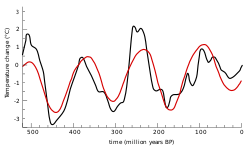過去5億年にわたる宇宙線フラックスの変動(赤;位相は反転)と海水温変化(黒)の相関[ 1] 鉄隕石 の宇宙線照射年代 、海水温 は化石 に含まれる同位体 のプロキシから再構築。 宇宙気候学 (うちゅうきこうがく、Cosmoclimatology)とは、地球の気候変動 に対する宇宙現象の影響を研究対象とした学問分野。用語は2007年 にスベンスマルクによって考案された[ 2]
宇宙気候学における仮説の一つに、付加的な雲核 の核形成(nucleation )による下部対流圏 における雲量 の変化に対する銀河宇宙線 の影響がある。その考えは提案中のもので、まだ証明されていない、地球の気候変動に対する太陽変動 の影響に関する仮説の一つである[ 3]
雲に及ぼす銀河宇宙線の影響を実験的に調べるため、CERN では2006年に陽子シンクロトロン(Proton Synchrotron )から発生させた荷電π中間子 の加速器ビームを用いてチャンバー内における核形成の測定が予備段階の実験として行われている[ 4]
一方、顕生代 にわたる長期の気候変動におよぼす銀河宇宙線の影響を調べた研究によれば、地球は1.35億年の周期で銀河系 のらせん状の腕(Spiral arm )を通過し、その銀河系の腕から多量の宇宙線を浴びたときに寒冷化傾向を示しており、過去5億年にわたって地球が浴びた宇宙線量の変調と気温変化の間に強い相関が見出されている[ 1] [ 5] [ 6] 大気イオン がエアロゾル を形成し、そのエアロゾルが雲粒 の凝結核 となり、雲が増加することで地球の太陽光反射率(アルベド )が上昇して寒冷化するというモデルが提案されている[ 7]
銀河宇宙線だけでなく、軌道要因等を含む太陽活動の変動[ 8] [ 9] [ 10] [ 11] [ 12] [ 13] 惑星間塵 [ 14] 宇宙塵 [ 15] [ 16] [ note 1]
ただし、星間ガス を介した気候への影響[ 17] [ note 2] Nir Shaviv の論文[ 18] [ 19] [ 20]
日本において宇宙気候学という用語が用いられた例として、1992年 の科学雑誌に高エネルギー宇宙物理学者の桜井邦朋 による記述がある[ 21] 1989年3月の磁気嵐 の原因である太陽フレア 現象や、宇宙空間における人間活動のための宇宙天気予報 、さらに小氷期 と太陽活動との関連において位置づけている。
小氷期は太陽活動の低下したマウンダー極小期 と時期が重なり、太陽などの天体活動と気候を関連付けた初期の研究対象の一つとなっている。マウンダー極小期 は1975年 に太陽物理学者のジャック・エディ (英語版 ) 1976年 に発表され[ 22]
^ a b Nir J. Shaviv and Ján Veizer (2003). “Celestial driver of Phanerozoic climate?” . GSA Today 13 (7): 4–10. doi :10.1130/1052-5173(2003)013<0004:CDOPC>2.0.CO;2 . http://www.phys.huji.ac.il/~shaviv/Ice-ages/GSAToday.pdf . online discussion
^ Henrik Svensmark (2007). “Cosmoclimatology: a new theory emerges” . Astronomy & Geophysics 48 (1): 1.18-1.24. doi :10.1111/j.1468-4004.2007.48118.x . http://www.spacecenter.dk/research/sun-climate/Scientific%20work%20and%20publications/svensmark_2007cosmoClimatology.pdf . ^ Kristjansson, J. E.; Kristiansen, J. (2000). “Is there a cosmic ray signal in recent variations in global cloudiness and cloud radiative forcing?”. Journal of Geophysical Research 105 (D9): 11851-11863. doi :10.1029/2000JD900029 . ^ J. Duplissy et al. (2010). “Results from the CERN pilot CLOUD experiment” . Atmos. Chem. Phys. 10 : 1635?1647. doi :10.5194/acp-10-1635-2010 . http://www.atmos-chem-phys.net/10/1635/2010/acp-10-1635-2010.pdf . ^ Nir J. Shaviv (2003). “The Spiral Structure of the Milky Way, Cosmic-Rays and Ice-Age Epochs on Earth” . New Astronomy 8 : 39. doi :10.1016/S1384-1076(02)00193-8 . http://atoc.colorado.edu/wxlab/atoc7500/shaviv2003.pdf . ^ K. Scherer et al. (2006). “Interstellar-Terrestrial Relations: Variable Cosmic Environments, The Dynamic Heliosphere, and Their Imprints on Terrestrial Archives and Climate” . Space Science Reviews 127 : 327-465. doi :10.1007/s11214-006-9126-6 . http://www.geo.tu-freiberg.de/environ_geology_seminar/cosmic_ray_climate.pdf . ^ Nigel D. Marsh and Henrik Svensmark Low Cloud Properties Influenced by Cosmic Rays Physical Review Letters, Vol.85, Iss. 23, 5004 (2000年12月4日)
^ Julien Emile-Geay et al. (2007). “El Niño as a mediator of the solar influence on climate” . Paleoceanography 22 : PA3210. doi :10.1029/2006PA001304 . http://www.7minds.org/climate/texts/Emile-Geay_et_al_PA07.pdf . ^ Alexander Ruzmaikin et al. (2006). “Is solar variability reflected in the Nile River?” . Journal of Geophysical Research 111 : D21114. doi :10.1029/2006JD007462 . https://hdl.handle.net/2014/40231 . ^ J. Austin et al. (2008). “Coupled chemistry climate model simulations of the solar cycle in ozone and temperature” . Journal of Geophysical Research 113 : D11306. doi :10.1029/2007JD009391 . http://www.gfdl.noaa.gov/bibliography/related_files/jaa0801.pdf . ^ Nicola Scafetta and Bruce J. West (2003). “Solar Flare Intermittency and the Earth’s Temperature Anomalies, The Dynamic Heliosphere, and Their Imprints on Terrestrial Archives and Climate” . Physical Review Letters 90 (24): 248701. doi :10.1103/PhysRevLett.90.248701 . http://www.fel.duke.edu/~scafetta/pdf/PRL48701.pdf . ^ David Deming (1999). “On the possible influence of extraterrestrial volatiles on Earth's climate and the origin of the oceans”. Palaeogeography, Palaeoclimatology, Palaeoecology 146 (1): 33-51. doi :10.1016/S0031-0182(98)00144-8 . ^ Paolo Gabrielli et al. (2006). “A climatic control on the accretion of meteoric and super-chondritic iridium–platinum to the Antarctic ice cap”. Earth and Planetary Science Letters 250 : 459-469. doi :10.1016/j.epsl.2006.08.015 . ^ Gisela Winckler et al. (2004). “Does interplanetary dust control 100 kyr glacial cycles?”. Quaternary Science Reviews 23 : 1873-1878. doi :10.1016/j.quascirev.2004.05.007 . ^ V. I. Ermakov et al. (2009). “Influence of cosmic rays and cosmic dust on the atmosphere and Earth’s climate”. Bulletin of the Russian Academy of Sciences: Physics 73 (3): 416-418. doi :10.3103/S1062873809030411 . ^ V. I. Ermakov et al. (2009). “The impact of cosmic dust on the Earth’s climate”. Moscow University Physics Bulletin 64 (2): 214-217. doi :10.3103/S0027134909020234 . ^ R. D. Tarsia et al. (1988). “The interstellar medium and the glacial eras during the Pleistocene” . Earth, Moon, and Planets 41 (2): 173-190. doi :10.1007/BF00056402 . http://adsabs.harvard.edu/full/1988EM%26P...41..173T . ^ Nir J. Shaviv (2002). “Cosmic Ray Diffusion from the Galactic Spiral Arms, Iron Meteorites, and a Possible Climatic Connection” . Physical Review Letters 89 (5): 051102. doi :10.1103/PhysRevLett.89.051102 . http://www.phys.huji.ac.il/~shaviv/articles/PRLice.pdf . ^ Story #34 from 100 Top Science Stories of 2002 in Discover Magazine ^ David Whitehouse (31 July 2002). “Galaxy 'may cause ice ages' ”. BBC news. 2010年8月2日 閲覧。 ^ 桜井邦朋「宇宙気候学の試み」 、『数理科学』 サイエンス社 1992年10月号 No.352、p66-69
^ John A. Eddy (1976). “The Maunder Minimum” . Science 192 (4245): 1189-1202. doi :10.1126/science.192.4245.1189 . オリジナル の2010年2月16日時点におけるアーカイブ。. https://web.archive.org/web/20100216030712/http://bill.srnr.arizona.edu/classes/182h/Climate/Solar/Maunder%20Minimum.pdf .
